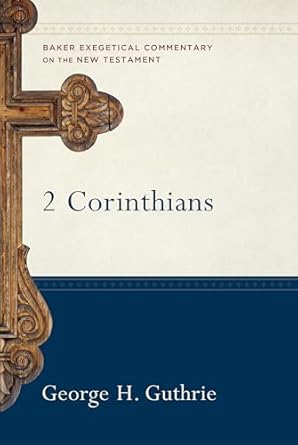New commentaries on 2 Corinthians do not hit the press every day, and it is noteworthy when one of 736 pages arrives from a respected New Testament scholar such as George Guthrie of Union University. We were eager to see Dr. Guthrie’s treatment of this rather neglected book, the latest addition to Baker’s outstanding Exegetical Commentary series, and today he talks to us about his new work.
Books At a Glance (Fred Zaspel):
Why has 2 Corinthians generally been one of the more neglected of Paul’s letters?
Guthrie:
 I think there are several reasons. Simply put, 2 Corinthians is a difficult book, described by Ralph Martin as “the despair of the commentator.” If 1 Corinthians comes off as Paul’s most “occasional” (and therefore “practical”) letter, 2 Corinthians seems confusing at points. Why the shift from travel narrative to treatise at 2:14 and then back to the travel narrative at 7:5? Why does the apostle seem to commend himself in one breath (e.g. 4:2) and deny that he is doing so in the next (5:12)? Why celebrate the Corinthians enthusiastically in chapter 7 only to get very, very cross as he moves into the final section of the book (10-13)? So the shifts and starts can feel disorienting if we do not grasp that there is a method to the madness. Further, there are a number of interpretive challenges that are neither easy to understand nor preach. What exactly was the event that caused Paul to despair for his life (1:8-11), or the conflict described in 2:5-11? How are we to understand the Triumphal Procession imagery of 2:14-16, or the “veil on Moses’ face” at 3:7-18, or Paul’s thorn in the flesh of chapter 12? We could go on and on. 2 Corinthians does not give up its riches easily!
I think there are several reasons. Simply put, 2 Corinthians is a difficult book, described by Ralph Martin as “the despair of the commentator.” If 1 Corinthians comes off as Paul’s most “occasional” (and therefore “practical”) letter, 2 Corinthians seems confusing at points. Why the shift from travel narrative to treatise at 2:14 and then back to the travel narrative at 7:5? Why does the apostle seem to commend himself in one breath (e.g. 4:2) and deny that he is doing so in the next (5:12)? Why celebrate the Corinthians enthusiastically in chapter 7 only to get very, very cross as he moves into the final section of the book (10-13)? So the shifts and starts can feel disorienting if we do not grasp that there is a method to the madness. Further, there are a number of interpretive challenges that are neither easy to understand nor preach. What exactly was the event that caused Paul to despair for his life (1:8-11), or the conflict described in 2:5-11? How are we to understand the Triumphal Procession imagery of 2:14-16, or the “veil on Moses’ face” at 3:7-18, or Paul’s thorn in the flesh of chapter 12? We could go on and on. 2 Corinthians does not give up its riches easily!
Books At a Glance:
You note that although 2 Corinthians is sometimes a difficult letter to interpret, it is also an interpreter’s “paradise.” Can you highlight some of its rewarding themes for us?
Guthrie:
How much space do we have here? Consider the strong encouragement of 1:3-7, perhaps Paul’s richest reflection on God’s redemption of our sufferings. Add to that the “treasure in terra cotta” passage in 4:7-15, or “the weight of glory” in 4:16-18, or the richness of his reflections on the resurrection body in 5:1-10. In chapters 8-9 we have the most extensive and practical exposition in the New Testament on giving. At every turn we find a depth of reflection on the nature of the Christian life and Christian hope. And of course all of this flows from Paul’s grasp of the gospel and gospel mission, so beautifully portrayed in the Triumphal Procession word picture of 2:14-16a, or the word-crafting of 5:17-21.
Books At a Glance:
Why do you describe 2 Corinthians as “the letter of the apostle’s broken yet buoyed heart”? How is this distinctive of this epistle? And how does this letter contribute to our understanding of the apostle Paul?
Guthrie:
2 Corinthians is the apostle’s most personal letter, coming as it does out of a time of tremendous suffering, anxiety, and brokenness. Paul has been deeply bruised emotionally and spiritually, and the “aroma” of a God-centered life arises from his season of brokenness and dependence. As we walk with the apostle in that moment, via the medium of this book, we learn about the true nature of authentic ministry (and authentic Christian living). We find that suffering is not abnormal for the believer/minister. It actually is a hallmark of authenticity, following a pattern lived out by our Lord. So Paul mentors us in “how to have perspective in the midst of suffering” and endure. For instance, we gain perspective in the face of God’s encouragement (1:3-7), in understanding suffering’s purposefulness in ministry (4:10-11), and in the experience of suffering weaning us away from self-exaltation; suffering serves as a conduit for gospel power (12:7-10). At every turn Paul gives us a wonderful example of how suffering can drive us to the Lord and the Lord can in turn give us the strength we need to endure the suffering.
The apostle’s heart is “buoyed” because he stays close to God, through Christ, and stays resolute with confidence in the gospel and the mission God has given him. Although Paul is brutally honest at points about his emotions, he never gets lost in self-pity. Thus he models an appropriate response to very difficult times of ministry.
Books At a Glance:
What was Paul trying to accomplish with this letter, and how is 2 Corinthians relevant for the church in our day and cultural context?
Guthrie:
At the heart of 2 Corinthians Paul simultaneously commends his own ministry as embodying the true gospel and sets his authentic ministry over against the agendas of the false teachers in Corinth. In short, he battles the interlopers for the very soul of the church, as we see for instance in 11:1-4. With Bruce Winter I understand the false teachers to be sophists, professional speakers who could wow a crowd and who embodied the values of Greco-Roman culture. They reveled in the world’s glory, financial gain, and power over the people to whom they “ministered.” But Paul asserts that they are false apostles, servants of Satan, who peddle-preach another Jesus, a false gospel, and a different spirit (11:4, 13-14).
Of course, the topic, “what to do in the face of false teaching?,” constitutes a topic wonderfully (and horribly) relevant for our day. I think the situation Paul faced was made more difficult by the nature of his mobile ministry — the interlopers were in Corinth and Paul was not — but we certainly face parallel challenges in our ministries today. Among other strategies for dealing with false teaching, the apostle offers reasoned explanation for his actions (e.g. 1:12-2:4), teaches a robust theology of Christian ministry (e.g. 2:14-4:6), and crafts a powerful, rhetorical rebuttal against those false ministers (e.g., 10-13). Notice that his approach is multifaceted. I am still working this out personally, but my sense is that in the face of a rising tide of false teaching in our American cultural context, we have much we can learn from Paul in this regard, even though the difference in our cultural contexts must be factored into the equation.
Books At a Glance:
Sketch out for us how 2 Corinthians “hangs together” as a whole. Can you give us a broad, bird’s eye view of the epistle?
Guthrie:
Sure. As you probably know, one of the ongoing questions surrounding 2 Corinthians concerns ….
Editor’s Note: We will continue our interview with Dr. Guthrie tomorrow.

